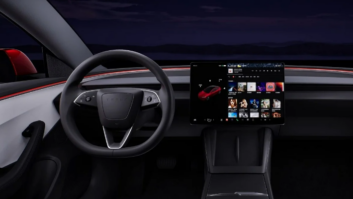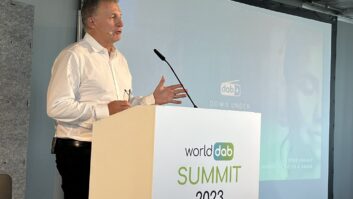 Scott Burnell lives in a world of application software. He is all about the apps.
Scott Burnell lives in a world of application software. He is all about the apps.
The global Head of the Ford Developer Program is one of the key thinkers behind Ford’s SYNC dashboard communications, navigation and entertainment ecosystem, now in its fourth generation.
SYNC 4, available beginning in 2021 Ford vehicles like the F-150 and Bronco, allows a radio station app on a consumer’s smartphone to connect over Bluetooth and control audio sources and dashboard infotainment with cloud-based connectivity and voice recognition.
The onboard communications center is smart enough to learn tendencies and listening patterns in order to provide suggestions to a driver based on their listening profile.
SYNC-enabled station apps can read data such as RDS, signal strength and audio source, even while running in the background on a mobile device. When granted permission, these apps can even control a vehicle’s radio tuner, completing tasks such as switching from HD-1 to HD-2 and other multicast channels in HD Radio, or performing automatic switching from the OTA signal to stream as a vehicle drives out of the reception area.

SYNC was released in 2007, the same year as the first iPhone, and is compatible with Apple CarPlay and Android Auto. It allows for integration of Alexa Auto and navigation apps such as Waze along with automatic software updates over Wi-Fi.
Burnell created and launched the Ford Developer Program, which the company says is considered the first mobile application developer ecosystem in the automotive industry. In addition, he managed the creation of the SmartDeviceLink (SDL) open source connectivity platform that also has been adopted by Toyota, Mazda, Subaru, PSA and additional OEMs and Tier 1 suppliers.
According to Burnell, “I can’t write a lick of code, but I do throw out ideas to the innovators about a vision of what could be. I say, ‘Here are the tools. What can you do with it?’”
Burnell is skeptical about whether radio broadcasters have done enough to remain a dominant presence in the dash of next-gen vehicles. His message to radio station owners is: “You have to be able to deliver content the way consumers want to receive it and consume it.”
Radio World asked Burnell for an update on his views about broadcast radio’s future in the connected car and the pace of dashboard technological change.
Radio World: How do mobile apps of radio stations connect to SYNC 4?
Scott Burnell: AppLink is a feature of SYNC that allows the mobile app to connect over Bluetooth and communicate with SYNC. In-vehicle app integration requires the AppLink code to be integrated into a specific application. And then that application can register in the vehicle.
In the United States, iHeartRadio has been a longtime partner with their app and always willing to try out new features. We’ve worked with JacApps often. They did the first multi-station group launch with Greater Media (later acquired by Beasley) stations. In Europe, Radioplayer brings broadcast apps into the car.
RW: And every radio station with a smartphone app can enable it to work in SYNC 4 if they want to?
Burnell: This is part of my personal frustration with the broadcast industry. Ford is offering individual stations the ability to have their app appear in the dashboard literally right next to the very entities they fear and worry about the most, satellite and streaming services, and they don’t take advantage of this opportunity.
RW: Consumer demand for entertainment options in the dash continues to expand along with the technology. How does Ford prioritize what goes in the dash and how it will appear?
Burnell: In the solution that we built, we do not have to decide. We are agnostic to what someone wants to listen to and how they want to listen to it.
There are features that we build. We do all the safety features, like lane keeping and cruise control. But when it comes down to the entertainment, having the open developer program and allowing any developer to work in that space, as long as it’s appropriate and they fit the criteria, then it’s the market that will decide.
So any radio station that wants to build an app to work in a Ford vehicle can, if it has our code in it. Then if a person hops in a Ford vehicle, the app just automatically works. So the market will choose if radio stations want to compete against a Pandora or Spotify in the vehicle.
Same thing with weather apps. We don’t say AccuWeather is the only way you can get weather in the vehicle. No, Weather Channel can be in there. Weather Bug or Weather Underground. It will all work in there. Whatever you use in your daily life, we want to allow you to bring your habits with you into the vehicle.
RW: You told us back in 2016 that broadcast radio had some advantages over music streaming services. That’s five years ago now. Is that still the case?
Burnell: I do, and let me clarify. Radio and the content that it delivers still have the exact same advantages. And by the advantages, I mean it is local. There is that local content and the human element. The jocks, the morning show folks and the sportscasters.
You look at all of those cool local and human elements, and they are missing from Pandora and Spotify. And then when you look at how to deliver that content. Broadcasters must deliver it in the way that people are consuming it. It doesn’t matter if you are delivering audio through the phone, tablet or over IP in the car. You have to be in all of those places.
RW: Radio broadcasters seem excited about hybrid radio, which allows for a radio tuner to switch from radio signal to an IP stream once it is out of listening range. Ford allows for that scenario?
Burnell: Yes. And it’s part of what I evangelize for mobile apps. Radio broadcasters need to adopt the technology that users engage with. If you are an AM broadcaster, good luck. There are not many kids running around with an AM tuner in their pocket. It’s part of the evolution.
So we do allow for audio switching if you are using a station app in the vehicle. The app can do it automatically so you don’t have to think “Oh now I need to switch to the stream to keep listening.”
RW: Speaking of AM. Now that the FCC has authorized AM radio stations to transition to an all-digital signal on a voluntary basis, what do you see as the future for AM in the car?
Burnell: I don’t have an official Ford opinion. Again, we always say we are agnostic to what people want to listen to and how they listen to it. But I know we would ask ourselves if that all-digital AM tuner kicks up the price for that piece of hardware in a new vehicle. We do think about those things all the time. AM radio really isn’t at the top of the list when people list reasons they are interested in a vehicle.
RW: During your appearance on Jacobs Media’s CES 2021 Virtual Tour earlier this year, you mentioned interactive advertising. How does that work with a radio station’s app?
Burnell: It’s all part of the development process and is an innovation idea at this point, but it could be a huge benefit. So a radio station app on a smartphone knows which station the tuner in the car is on. It can use GPS from the vehicle. Using some additional pieces of data in the car there are a lot of resources.
So if a radio station app on a phone and running, it’s connected to the head unit via Bluetooth. The radio app knows the tuner is tuned to your radio station. It knows the ad order, so as the Burger King ad airs the app can send a notification of a special offer at Burger King to display on the SYNC 4 screen.
RW: You work in a technology space that demands constant innovation. How does that add to the complexities of your job at Ford?
Burnell: Well, I work in the automotive industry, which is extremely slow. The balance to all that is it is a three- to five-year turnaround to engineer a new vehicle or body styling change.
I’m working now on the next generation of SYNC, and in fact we just announced that Ford vehicles will be running Android as the operating system beginning in 2023; I’ve been working on that since February of 2020.
[Editor’s note: Once the Android integration occurs, consumers will be introduced to embedded Android apps running in the vehicle and will still be able to connect to SYNC through an Android smartphone for apps running on Android Auto. Ford’s new system will still be compatible with Apple CarPlay via a smartphone with Bluetooth.]
RW: And voice control in the car will be even more advanced with each generation of technology?
Burnell: Voice is a far better implementation than reaching and touching a screen and looking away from the road. We have done some integration with Alexa and will going forward with Google Assistant now that we are going to implement the Android operating system.
RW: Sounds like the autonomous vehicle will be the ultimate game-changer in terms of entertainment possibilities in the car?
Burnell: The trajectory is that the vehicle will become more like a living room with entertainment options. That is where it’s going. And with a lot of multitasking going on. There will be traditional media consumption going on but it will also have some unique capabilities. Like context-aware content.
And the whole passenger economy will further diversify and expand media usage in the vehicle.
RW: Is Ford banking on a more smartphone-like in-car experience for its customers?
Burnell: People want to bring what they are doing outside the car to the inside of the car. As they build these habits people don’t typically seek out different media options. People don’t seek out the radio in the car necessarily because they are not listening to radio outside the car.
Infinite Dial studies from Edison show the number of radios in American households dropping quickly. It’s a lot of smart speakers and smartphones now.
That’s the shot across the bow of radio broadcasters. (Broadcasters) say, “Wait, but we have been in cars for 100 years.” And that’s true, but the people buying cars right now don’t care about that. These are the people who watch Netflix on any device they want. They really don’t watch regular TV. They listen to music on Spotify on multiple devices and they don’t listen to the radio.
If consumers don’t build the habit of listening to the radio outside the car, they won’t develop the habit of listening to radio inside the car.
RW: So could Ford someday no longer include a conventional radio receiver in cars if demand for them drops?
Burnell: I don’t work on the tuner side so I have no idea if that would ever happen. But if you think about it, every automaker and any technology or hardware provider is looking at the cost of installing every little piece that goes into a product, right down to every washer in a car.
We already have modems in the car and they are not going away because they are simply so important for the autonomous vehicle. If we have technology and hardware that can bring in an IP stream over cellular through a modem, and we have hardware bringing a FM radio signal through broadcast and they are doing essentially the same thing, which direction do you think car companies will evolve to? So (for broadcasters) to say they are just going to broadcast and it’s going to be a tuner in the car is shortsighted.












